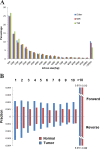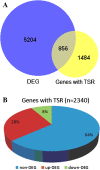The global landscape of intron retentions in lung adenocarcinoma
- PMID: 24646369
- PMCID: PMC3999986
- DOI: 10.1186/1755-8794-7-15
The global landscape of intron retentions in lung adenocarcinoma
Abstract
Background: The transcriptome complexity in an organism can be achieved by alternative splicing of precursor messenger RNAs. It has been revealed that alternations in mRNA splicing play an important role in a number of diseases including human cancers.
Methods: In this study, we exploited whole transcriptome sequencing data from five lung adenocarcinoma tissues and their matched normal tissues to interrogate intron retention, a less studied alternative splicing form which has profound structural and functional consequence by modifying open reading frame or inserting premature stop codons.
Results: Abundant intron retention events were found in both tumor and normal tissues, and 2,340 and 1,422 genes only contain tumor-specific retentions and normal-specific retentions, respectively. Combined with gene expression analysis, we showed that genes with tumor-specific retentions tend to be over-expressed in tumors, and the abundance of intron retention within genes is negatively related with gene expression, indicating the action of nonsense mediated decay. Further functional analysis demonstrated that genes with tumor-specific retentions include known lung cancer driver genes and are found enriched in pathways important in carcinogenesis.
Conclusions: We hypothesize that intron retentions and consequent nonsense mediated decay may collectively counteract the over-expression of genes promoting cancer development. Identification of genes with tumor-specific retentions may also help develop targeted therapies.
Figures


References
-
- Imielinski M, Berger AH, Hammerman PS, Hernandez B, Pugh TJ, Hodis E, Cho J, Suh J, Capelletti M, Sivachenko A, Sougnez C, Auclair D, Lawrence MS, Stojanov P, Cibulskis K, Choi K, de Waal L, Sharifnia T, Brooks A, Greulich H, Banerji S, Zander T, Seidel D, Leenders F, Ansén S, Ludwig C, Engel-Riedel W, Stoelben E, Wolf J, Goparju C. Mapping the hallmarks of lung adenocarcinoma with massively parallel sequencing. Cell. 2012;7(6):1107–1120. doi: 10.1016/j.cell.2012.08.029. - DOI - PMC - PubMed
-
- Kwak EL, Bang YJ, Camidge DR, Shaw AT, Solomon B, Maki RG, Ou SH, Dezube BJ, Janne PA, Costa DB, Varella-Garcia M, Kim WH, Lynch TJ, Fidias P, Stubbs H, Engelman JA, Sequist LV, Tan W, Gandhi L, Mino-Kenudson M, Wei GC, Shreeve SM, Ratain MJ, Settleman J, Christensen JG, Haber DA, Wilner K, Salgia R, Shapiro GI, Clark JW. Anaplastic lymphoma kinase inhibition in non-small-cell lung cancer. N Engl J Med. 2010;7(18):1693–1703. doi: 10.1056/NEJMoa1006448. - DOI - PMC - PubMed
Publication types
MeSH terms
LinkOut - more resources
Full Text Sources
Other Literature Sources
Medical

